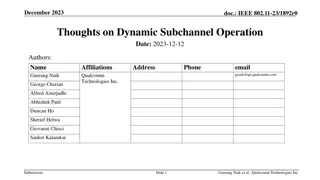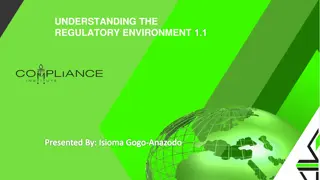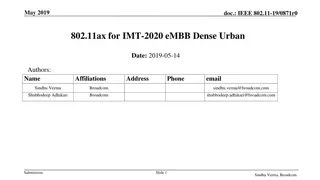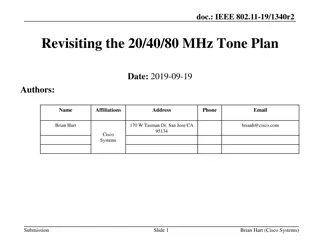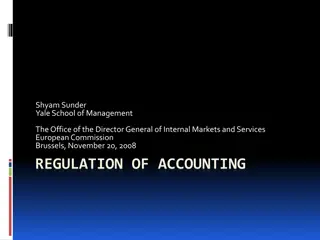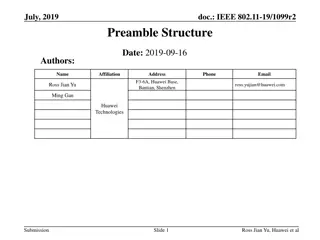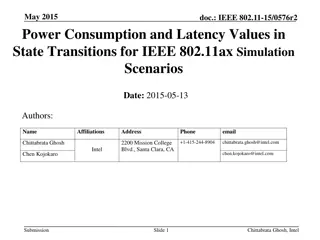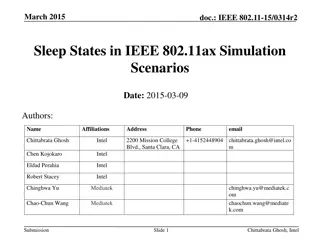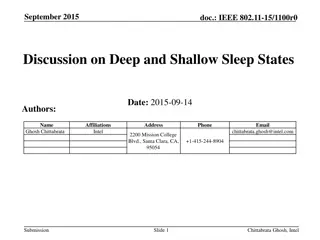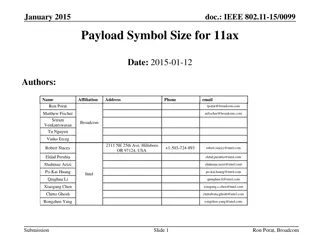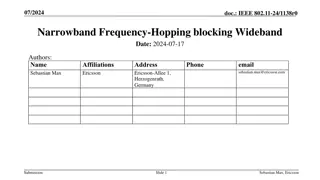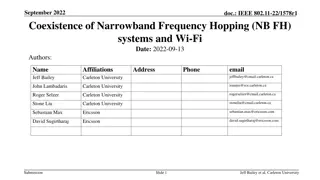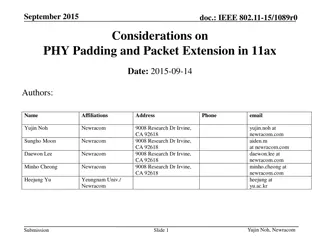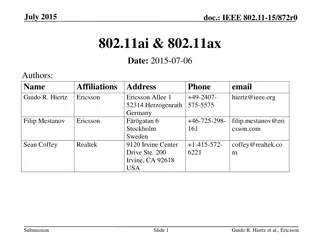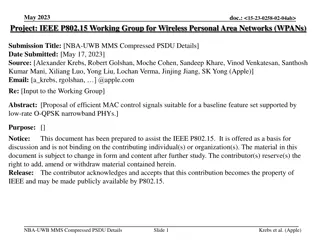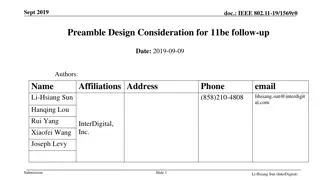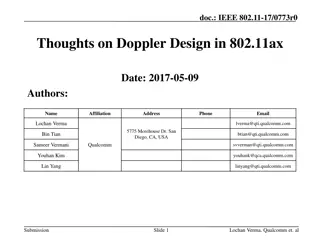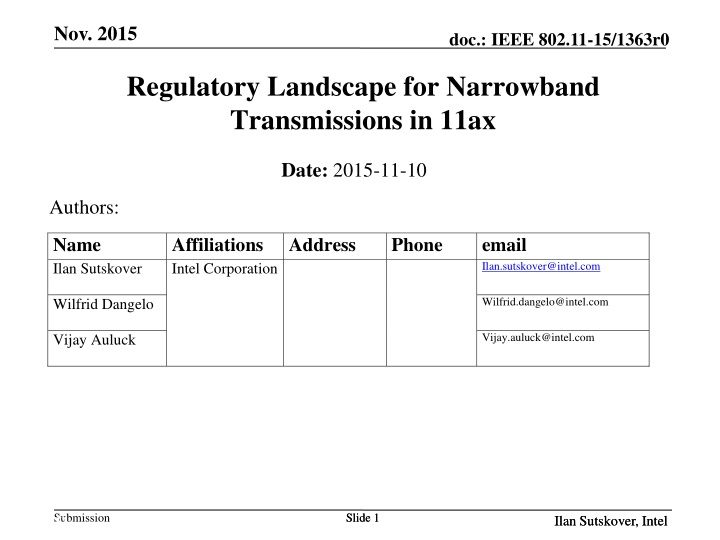
IEEE 802.11-15/1363r0 Regulatory Landscape for Narrowband Transmissions
Explore the regulatory landscape for narrowband transmissions in IEEE 802.11ax standard, addressing issues like minimum bandwidth requirements and specific bandwidth definitions in regions like ETSI, Japan, and Korea. Discover the impact of duty cycle on spectrum allocation and simulation results of narrowband data transmission.
Uploaded on | 0 Views
Download Presentation

Please find below an Image/Link to download the presentation.
The content on the website is provided AS IS for your information and personal use only. It may not be sold, licensed, or shared on other websites without obtaining consent from the author. If you encounter any issues during the download, it is possible that the publisher has removed the file from their server.
You are allowed to download the files provided on this website for personal or commercial use, subject to the condition that they are used lawfully. All files are the property of their respective owners.
The content on the website is provided AS IS for your information and personal use only. It may not be sold, licensed, or shared on other websites without obtaining consent from the author.
E N D
Presentation Transcript
Nov. 2015 doc.: IEEE 802.11-15/1363r0 Regulatory Landscape for Narrowband Transmissions in 11ax Date: 2015-11-10 Authors: Name Ilan Sutskover Affiliations Intel Corporation Address Phone email Ilan.sutskover@intel.com Wilfrid.dangelo@intel.com Wilfrid Dangelo Vijay.auluck@intel.com Vijay Auluck Submission Il Slide 1 Slide 1 Ilan Sutskover, Intel Ilan Sutskover, Intel
Nov. 2015 doc.: IEEE 802.11-15/1363r0 Introduction IEEE 802.11ax defines narrow-band transmissions such as 2MHz, 4MHz and 8MHz This presentation identifies current regulatory requirements that are not aligned with the new 11ax signals Submission Il Slide 2 Ilan Sutskover, Intel
Nov. 2015 doc.: IEEE 802.11-15/1363r0 Issue #1: Minimum BW Minimum BW requirement of 5MHz nominal BW exists in ETSI EN 301 893 [1] for 5GHz band only No such requirement for 2.4GHz band See also [2]. Minimum Nominal BW is: EN 301 893: The widest band of frequencies, inclusive of guard bands, assigned to a single channel When equipment has simultaneous transmissions in non-adjacent channels, each power envelope shall be considered separately Such that occupied BW (defined in ETSI, Japan and Korea) is between 80% to 100% of the nominal BW The 26-tone RU is slightly above 2MHz, which is currently not allowed by ETSI Submission Il Slide 3 Ilan Sutskover, Intel
Nov. 2015 doc.: IEEE 802.11-15/1363r0 Issue #2: BW-Specific Definitions Japan and Korea have regulations that specify explicitly the allowed BW of transmission Currently, only 20MHz, 40MHz, 80MHz and 160MHz are supported Transmission at BW different than the above is forbidden Hence, 2MHz , 4MHz , 8MHz and others are not allowed for now Submission Il Slide 4 Ilan Sutskover, Intel
Nov. 2015 doc.: IEEE 802.11-15/1363r0 Narrowband-data Tx Spectrum Simulation results. Legacy preamble is 20MHz, all the rest is ~2MHz (6 11ac tones) Some non-linearity is added to transmissions. Duty cycle has a big impact Submission Il Slide 5 Ilan Sutskover, Intel Ilan Sutskover, Intel
Nov. 2015 doc.: IEEE 802.11-15/1363r0 Duty Cycle Impact on Spectrum 11ax packets have a legacy preamble which is wide (20/40/80) compared to the narrowband data Signal spectrum is a superposition of the preamble spectrum and the data spectrum, with their relative length proportion When testing with very long packets, preamble impact can be made small, and occupied BW will approach the data BW (e.g., 2MHz) When testing with relatively short packets, preamble impact is high and occupied bandwidth (OBW) approaches (from below) the preamble BW Submission Il Slide 6 Ilan Sutskover, Intel
Nov. 2015 doc.: IEEE 802.11-15/1363r0 Mask Regulatory Status Today s status: ETSI standard defines masks It follows so far IEEE 802.11 mainly since 802.11 was the main standard in 2.4GHz and 5GHz bands Mask is defined relatively to nominal BW FCC & Korea do not specify masks Japan defines ACLR in its standard ACLR is defined for the specified BW of 20/40/80/160 China requires that mask will be 802.11 compliant Submission Il Slide 7 Ilan Sutskover, Intel
Nov. 2015 doc.: IEEE 802.11-15/1363r0 Issue #3: Mask ETSI masks are defined as a function of nominal BW Nominal BW has direct relationship to measurable OBW Whether IEEE defines narrowband masks or not, ETSI masks will address signals according to their (occupied) BW With OBW being impacted by duty-cycle, status of ETSI masks for narrowband 11ax signals is not clear Yet IEEE 20/40/80/160 masks are not suitable according to ETSI Note: ETSI does define masks differently for cellular transmissions, allowing same masks for various number of resource blocks (incl. in uplink) Non-contiguous transmissions of the AP (such as inclusion of zero power RU) is currently not blocked by 11ax This could be another issue with defined masks IEEE spectral flatness requirements for 11ax are TBD Submission Il Slide 8 Ilan Sutskover, Intel
Nov. 2015 doc.: IEEE 802.11-15/1363r0 Test Modes 11ax will have more test cases than 11ac due to the additional modes If properly defined, it may be less than the cross product of the preamble BW and the data BW possibilities To emphasize the importance of this the Japan 11ac regulatory certification report, including hundreds of pages, is an example Identification of the transmission A gap: to facilitate world-wide testing, each of the allowed modes of transmission must be uniquely identified Note: Japan s standard addresses channelization and as long as it is not technology neutral it may need to address also the 11ax transmissions inside the channel Submission Il Slide 9 Ilan Sutskover, Intel
Nov. 2015 doc.: IEEE 802.11-15/1363r0 PSD It is noted that PSD limitations exist in most of the countries, including FCC and ETSI Current PSD limitations are such that maximum TX power is proportional to the BW At 5GHz band, 2MHz transmission is limited to device Tx Power EIRP of 20dBm (FCC) and 13dBm (ETSI) UNII-3 (channels above 145) PSD requirement are more relaxed FCC number assumes antenna gain (including beamforming gain) is less than 6dBi, or else further reduction is required Submission Il Slide 10 Ilan Sutskover, Intel
Nov. 2015 doc.: IEEE 802.11-15/1363r0 Summary The narrow-band transmissions allowed by 802.11ax were shown to have currently the following issues: Minimum BW requirement of 5MHz exists in ETSI at the 5GHz band Some countries allow transmissions only within explicitly stated bandwidth (20/40/80/160) Mask is measured by ETSI, defined relatively to OBW Not exactly same mask of IEEE Duty cycle impacts OBW testing issue Narrow band transmission lacks identification terminology for world-wide testing (incl. regulatory) Submission Il Slide 11 Ilan Sutskover, Intel
Nov. 2015 doc.: IEEE 802.11-15/1363r0 References [1] ETSI EN 301 893 v1.8.1, Harmonized European Standard, Broadband Radio Access Networks (BRAN); 5 GHz high performance RLAN [2] IEEE 802.11-15/0375r1, Minimum Resource Granularity in OFDMA Submission Il Slide 12 Ilan Sutskover, Intel Ilan Sutskover, Intel

